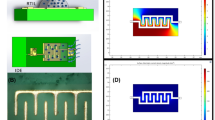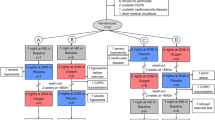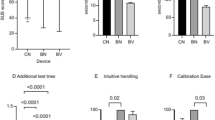Abstract
Background:
Exhaled nitric oxide (eNO) is an endogenous gas involved in airway pathophysiology and is determined in orally exhaled air by various techniques. However, traditional single-breath technique (eNOSB) requires active cooperation and is not always easily practicable (especially in young children); simpler techniques including tidal breathing measurements (eNOTB) are not standardized. The aim of this study was to evaluate the possible correlation and correspondence between eNOSB and eNOTB and the impact of potential confounders in children with chronic adenotonsillar disease.
Methods:
Eighty-six children (mean age 8.7 ± 3.2 y) underwent eNO assessment by means of eNOSB and eNOTB. The correlation among eNOTB, eNOSB, and other potential confounders (i.e., gender, age, weight, height, BMI, and passive smoking exposure) were studied.
Results:
The analyses showed a poor correspondence between eNOSB and eNOTB, with the latter underestimating (P < 0.001) mean eNO values: 6.4 parts per billion (ppb) (95% confidence interval (CI): 8.4–11.4 ppb) vs. 9.8 ppb (95% CI: 5.6–7.3 ppb). A greater correlation was found between eNOSB and eNOTB in children younger than 6 y. Only eNOSB and age predicted eNOTB (R2 = 43.6%).
Conclusion:
eNOTB is not a good predictor of eNOSB in children. Constant-flow eNOSB is the technique of choice for eNO assessment in young children.
Similar content being viewed by others
Log in or create a free account to read this content
Gain free access to this article, as well as selected content from this journal and more on nature.com
or
References
Baraldi E, de Jongste JC; European Respiratory Society/American Thoracic Society (ERS/ATS) Task Force. Measurement of exhaled nitric oxide in children, 2001. Eur Respir J 2002;20:223–37.
American Thoracic Society, European Respiratory Society. ATS/ERS recommendations for standardized procedures for the online and offline measurement of exhaled lower respiratory nitric oxide and nasal nitric oxide, 2005. Am J Respir Crit Care Med 2005;171:912–30.
Kharitonov SA, Yates D, Robbins RA, Logan-Sinclair R, Shinebourne EA, Barnes PJ . Increased nitric oxide in exhaled air of asthmatic patients. Lancet 1994;343:133–5.
Martin U, Bryden K, Devoy M, Howarth P . Increased levels of exhaled nitric oxide during nasal and oral breathing in subjects with seasonal rhinitis. J Allergy Clin Immunol 1996;97:768–72.
Kharitonov SA, Yates D, Barnes PJ . Increased nitric oxide in exhaled air of normal human subjects with upper respiratory tract infections. Eur Respir J 1995;8:295–7.
Hofer M, Mueller L, Rechsteiner T, Benden C, Boehler A . Extended nitric oxide measurements in exhaled air of cystic fibrosis and healthy adults. Lung 2009;187:307–13.
Torretta S, Bossi A, Capaccio P, et al. Nasal nitric oxide in children with adenoidal hypertrophy: a preliminary study. Int J Pediatr Otorhinolaryngol 2010;74:689–93.
Torretta S, Marchisio P, Esposito S, et al. Exhaled nitric oxide levels in children with chronic adenotonsillar disease. Int J Immunopathol Pharmacol 2011;24:471–80.
Kasperska-Zajac A, Brzoza Z, Czecior E, Rogala B, Polok A, Namyslowski G . Elevated levels of exhaled nitric oxide in recurrent tonsillitis. Eur Respir J 2008;31:909–10.
Silkoff PE, McClean PA, Slutsky AS, et al. Marked flow-dependence of exhaled nitric oxide using a new technique to exclude nasal nitric oxide. Am J Respir Crit Care Med 1997;155:260–7.
Jöbsis Q, Schellekens SL, Kroesbergen A, Hop WC, de Jongste JC . Sampling of exhaled nitric oxide in children: end-expiratory plateau, balloon and tidal breathing methods compared. Eur Respir J 1999;13:1406–10.
Franklin PJ, Turner SW, Mutch RC, Stick SM . Comparison of single-breath and tidal breathing exhaled nitric oxide levels in infants. Eur Respir J 2004;23:369–72.
Daniel PF, Klug B, Valerius NH . Measurement of exhaled nitric oxide in young children during tidal breathing through a facemask. Pediatr Allergy Immunol 2005;16:248–53.
Scadding G, Scadding GK . Update on the use of nitric oxide as a noninvasive measure of airways inflammation. Rhinology 2009;47:115–20.
Carraro S, Cutrone C, Cardarelli C, Zanconato S, Baraldi E . Clinical application of nasal nitric oxide measurement. Int J Immunopathol Pharmacol 2010;23:Suppl 1:50–2.
Kissoon N, Duckworth LJ, Blake KV, Murphy SP, Taylor CL, Silkoff PE . FE(NO): relationship to exhalation rates and online versus bag collection in healthy adolescents. Am J Respir Crit Care Med 2000;162(2 Pt 1):539–45.
Canady RG, Platts-Mills T, Murphy A, Johannesen R, Gaston B . Vital capacity reservoir and online measurement of childhood nitrosopnea are linearly related. Clinical implications. Am J Respir Crit Care Med 1999;159:311–4.
Franklin PJ, Turner SW, Mutch RC, Stick SM . Measuring exhaled nitric oxide in infants during tidal breathing: methodological issues. Pediatr Pulmonol 2004;37:24–30.
Holliday JC, Moore GF, Moore LA . Changes in child exposure to secondhand smoke after implementation of smoke-free legislation in Wales: a repeated cross-sectional study. BMC Public Health 2009;9:430.
Cassano P, Gelardi M, Cassano M, Fiorella ML, Fiorella R . Adenoid tissue rhinopharyngeal obstruction grading based on fiberendoscopic findings: a novel approach to therapeutic management. Int J Pediatr Otorhinolaryngol 2003;67:1303–9.
Marseglia GL, Poddighe D, Caimmi D, et al. Role of adenoids and adenoiditis in children with allergy and otitis media. Curr Allergy Asthma Rep 2009;9:460–4.
American Academy of Pediatrics. Subcommittee on management of otitis media with effusion. Otitis media with effusion. Pediatrics 2004;113:1412–29.
American Academy of Pediatrics. Subcommittee on management of acute otitis media. Diagnosis and management of acute otitis media. Pediatrics 2004;113:1451–65.
Paradise JL, Bluestone CD, Bachman RZ, et al. Efficacy of tonsillectomy for recurrent throat infection in severely affected children. Results of parallel randomized and nonrandomized clinical trials. N Engl J Med 1984;310:674–83.
Kharitonov SA, Rajakulasingam K, O’Connor B, Durham SR, Barnes PJ . Nasal nitric oxide is increased in patients with asthma and allergic rhinitis and may be modulated by nasal glucocorticoids. J Allergy Clin Immunol 1997;99(1 Pt 1):58–64.
Franklin PJ, Taplin R, Stick SM . A community study of exhaled nitric oxide in healthy children. Am J Respir Crit Care Med 1999;159:69–73.
Kharitonov SA, Gonio F, Kelly C, Meah S, Barnes PJ . Reproducibility of exhaled nitric oxide measurements in healthy and asthmatic adults and children. Eur Respir J 2003;21:433–8.
Buchvald F, Baraldi E, Carraro S, et al. Measurements of exhaled nitric oxide in healthy subjects age 4 to 17 years. J Allergy Clin Immunol 2005;115:1130–6.
Malmberg LP, Petäys T, Haahtela T, et al. Exhaled nitric oxide in healthy nonatopic school-age children: determinants and height-adjusted reference values. Pediatr Pulmonol 2006;41:635–42.
Kovesi T, Kulka R, Dales R . Exhaled nitric oxide concentration is affected by age, height, and race in healthy 9- to 12-year-old children. Chest 2008;133:169–75.
Author information
Authors and Affiliations
Corresponding author
Rights and permissions
About this article
Cite this article
Torretta, S., Bossi, A., Brevi, A. et al. Head-to-head comparison of single-breath and tidal-breath exhaled nitric oxide measurements. Pediatr Res 73, 221–225 (2013). https://doi.org/10.1038/pr.2012.164
Received:
Accepted:
Published:
Issue date:
DOI: https://doi.org/10.1038/pr.2012.164



